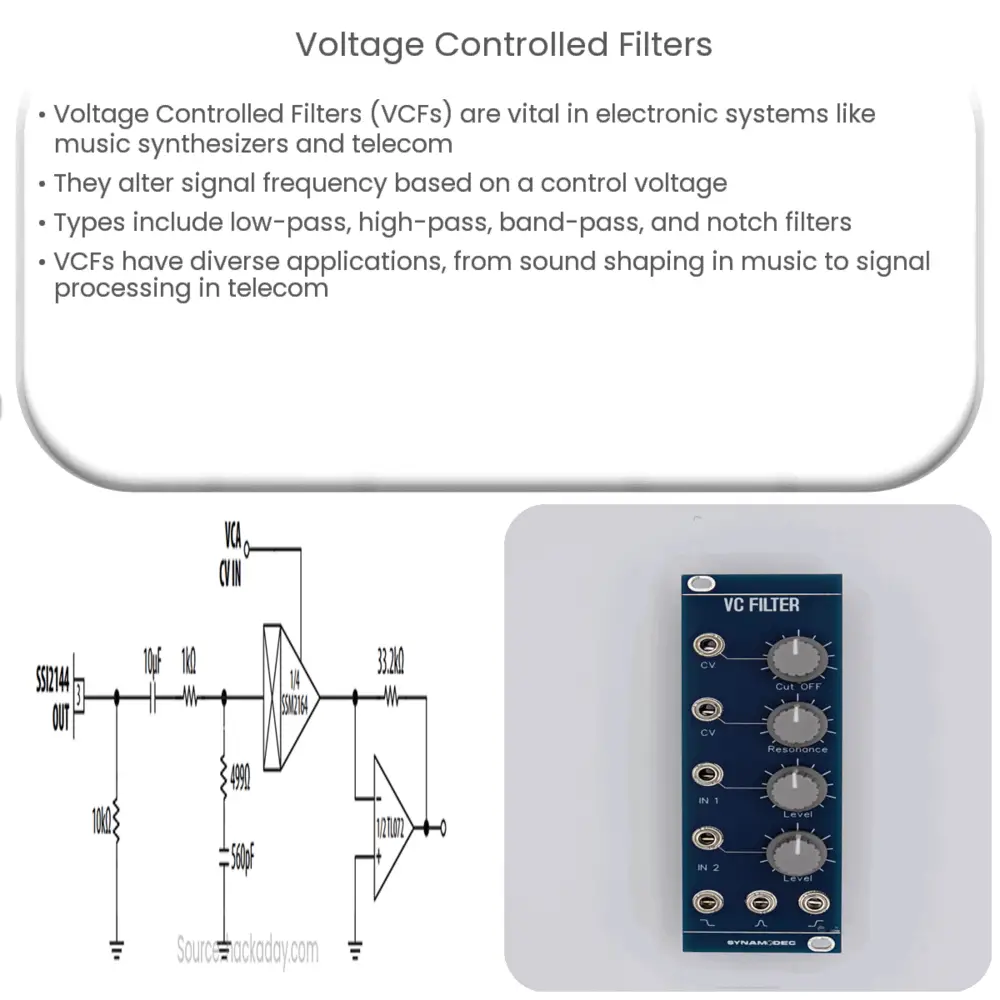Explore the world of Voltage Controlled Filters (VCFs), their types, applications, design, challenges, and future in our comprehensive guide.

Voltage Controlled Filters: An Overview
Voltage Controlled Filters (VCFs) are fundamental components in various electronic systems, including music synthesizers, telecommunications, and control systems. They belong to a broader category of voltage-controlled devices that also include voltage-controlled oscillators (VCOs) and voltage-controlled amplifiers (VCAs).
Functionality and Importance of VCFs
At their core, VCFs allow the frequency characteristics of a signal to be altered or ‘filtered’ based on an applied control voltage. The ability to modulate the cutoff frequency dynamically makes VCFs invaluable in audio processing and signal processing applications.
Types of Voltage Controlled Filters
- Low-pass Filters: These filters allow frequencies below a certain cutoff point (set by the control voltage) to pass through while attenuating frequencies above the cutoff.
- High-pass Filters: Contrary to low-pass filters, high-pass filters attenuate frequencies below the cutoff point and allow those above it to pass through.
- Band-pass Filters: Band-pass filters are designed to allow a certain ‘band’ or range of frequencies to pass through while attenuating frequencies outside this band.
- Notch Filters: Also known as band-reject or band-stop filters, notch filters attenuate a specific band of frequencies while allowing those outside the band to pass through.
Applications of Voltage Controlled Filters
VCFs have a myriad of applications across several industries. Let’s highlight a few.
- Music Synthesizers: VCFs are the heart of many music synthesizers, where they sculpt the harmonic content of sounds. They allow for dynamic sound shaping, bringing life to electronic music.
- Telecommunications: In telecom systems, VCFs are employed in frequency modulation and demodulation, signal separation, and interference reduction.
Despite their varied uses, the fundamental principle behind all VCFs remains the same: the use of a control voltage to manipulate a signal’s frequency characteristics. This is a reflection of the general trend in electronics towards greater control and precision, enabling the creation of more sophisticated devices and systems.
Design and Construction of Voltage Controlled Filters
VCFs can be built using various techniques and components, with some of the most common being operational amplifiers (op-amps), transistors, and digital signal processing (DSP) chips. The choice of components and the overall design will greatly influence the performance and characteristics of the VCF, including aspects such as the filter’s response curve, resonance, and signal-to-noise ratio.
- Operational Amplifiers: Op-amps are often used in the construction of analog VCFs due to their versatility and performance. They can easily be configured to implement different types of filters.
- Transistors: Transistor-based VCFs are popular in certain applications due to their unique sound characteristics, particularly in music synthesizers.
- Digital Signal Processing Chips: DSP chips can implement VCFs in software, offering incredible flexibility and precision. They are commonly used in digital audio workstations (DAWs) and digital synthesizers.
Challenges and Limitations
Designing and implementing a VCF is not without challenges. Factors such as power consumption, component tolerance, signal integrity, and thermal stability must be taken into account. Moreover, analog VCFs tend to produce a certain amount of noise, which can degrade the quality of the filtered signal. Digital VCFs, on the other hand, require considerable computational resources and can introduce latency, which may be an issue in real-time applications.
Future of Voltage Controlled Filters
With the rapid advancements in technology, the future of VCFs is quite promising. New materials and technologies, such as nanotechnology and quantum computing, might enable the creation of VCFs with unprecedented levels of performance and miniaturization. Moreover, as digital audio technology continues to evolve, digital VCFs will likely become even more powerful and efficient.
Conclusion
In conclusion, voltage controlled filters play a critical role in the modern electronic world. From shaping the sound of music to facilitating reliable communication, their influence is broad and significant. Despite the challenges in their design and construction, ongoing technological advancements promise to make VCFs even more capable and versatile in the future. As we continue to push the boundaries of what is possible with electronics, the importance of these dynamic components is set to only increase.

